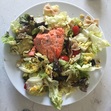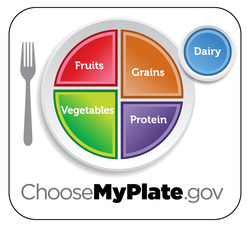|
While the title may be a bit dramatic, it’s also pretty accurate when you think about how it can apply to your life & MEAL PLANNING. A key to succeeding at any goal – be it a strategic business goal or a personal health & wellness goal – is to have a SMART goal that acts as your PLAN. “I want to be better at planning my meals” is more of a desire than a goal. A SMART goal around meal planning would be “I will prepare at least 5 dinners this week from food on hand, eating dinner out no more than 2 times”.
Where you are in your meal planning and where you PLAN (not want) to go will guide your specific next steps, here’s a few things to get you started with your plan:
 My Back Up Plan: Salmon Salad My Back Up Plan: Salmon Salad Ironically, I was invited to present “Meal Planning Strategies” at a worksite earlier this week. In preparing for my presentation, I let my meal prep portion of my plan slip. The night I came home from the presentation I had to go with a back-up plan and re-work the rest of the week to be sure nothing went to waste! Some of my most favorite meals have come about as a result of needing to rely on staples or leftovers for a back-up plan. What is your favorite or go-to “back-up meal”? or is it a drive thru ;) Mash banana and thoroughly mix in the next 3 ingredients, as well as honey if using. Add in the oats and chips, mix and cover. Place in refrigerator for at least 30 minutes to make forming the bites less stressful!
1 large or 3 small bites prepared as above will provide 100 calories, 4g fat, 13g carbs, 2g fiber, 3g sugar, 3g protein
1 Comment
|
CarolineI'm a busy mom with a passion for sharing practical advice to help you live the healthy and balanced life you envision. Warning: the information is evidenced-based, but the delivery will often contain humor! Archives
May 2017
|

